
A lip piercing is a type of body piercing that penetrates the lips or the area surrounding the lips, which can be pierced in a variety of ways.

A navel piercing is a type of piercing located through the skin of the navel. It is most commonly located on the upper fold of skin, but can also be effected underneath or around the edges of the navel. It may heal quickly and with no irritations, like an ear piercing, or may heal more like a surface piercing with the associated extended healing time. Healing usually takes around 6–12 months, but varies by person due to differences in physiology. Navel piercings reject less frequently than most other surface piercings, but the rejection rate is nonetheless higher than non-surface piercings. A properly effected navel piercing involves piercing the skin surrounding the navel with the initial wound inside of the navel canal. This can be done at any angle where there is a clear flap of skin, but the most prevalent form of navel piercing is through the upper rim of the navel.

Nose piercing is the piercing of the skin or cartilage which forms any part of the nose, normally for the purpose of wearing jewelry, called a nose-jewel. Among the different varieties of nose piercings, the nostril piercing is the most common.

An earring is a piece of jewelry attached to the ear via a piercing in the earlobe or another external part of the ear. Earrings have been worn by people in different civilizations and historic periods, often with cultural significance.

A dydoe is a type of male genital piercing that passes through the ridge of the glans on the head of the penis. They are often done in pairs. Less often, a "king's crown" is where several dydoes are placed around the head of the penis. The jewelry is usually a 12 gauge, straight barbell with a ball on either end, although a ring may be used at a higher chance of rejection. A deep dydoe is one that uses a longer barbell and exits near the tip of the penis.
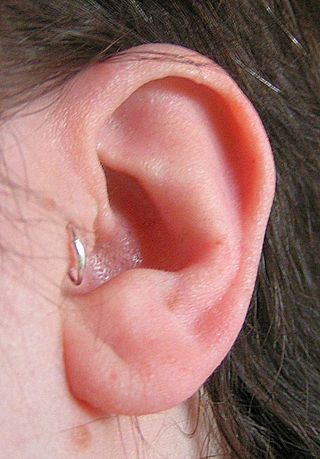
A tragus piercing is the perforation of the tragus, which projects immediately in front of the ear canal, for the purpose of inserting and wearing a piece of jewelry. The piercing itself is usually made with a small gauge hollow piercing needle, and typical jewelry would be a small diameter captive bead ring or small gauge post style piercing jewelry. A related piercing is known as the antitragus piercing.
In modern Western body piercing, a wide variety of materials are used. Some cannot be autoclaved, and others may induce allergic reactions, or harbour bacteria. Certain countries, such as those belonging to the EU, have legal regulations specifying which materials can be used in new piercings.
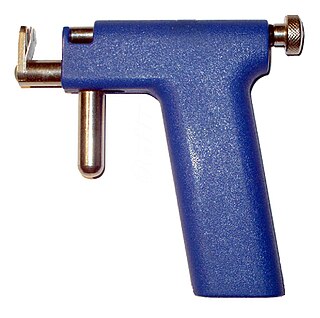
An ear piercing instrument is a device designed to pierce earlobes by driving a pointed starter earring through the lobe. Piercing guns may be reusable or disposable. Piercing guns are typically used in mall jewelry shops.
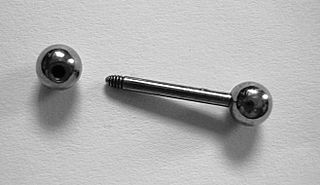
Barbell style piercing jewelry is composed of a straight bar with a bead on each end, one or both beads unscrewable for removal and/or changing of the beads. Often one of the beads is fixed, either via epoxy or welding, so that only one bead is used to install or remove the jewelry. Barbell threads are usually right-handed.

An industrial piercing, also known as a scaffold piercing (UK/Ireland) or construction piercing, is any ear piercing that consists of two pierced holes connected with a single piece of jewelry. These piercings typically consist of a double perforation of the upper ear cartilage specifically. Two piercings must be made: one is fairly close to the head, while the second one is further down the helix on the opposite side of the ear. Industrial piercings that are vertical are also known as a suicide industrial.
Stretching, in the context of body piercing, is the deliberate expansion of a healed piercing for the purpose of wearing certain types of jewelry. Ear piercings are the most commonly stretched piercings, with nasal septum piercings, tongue piercings and lip piercings/lip plates following close behind. While all piercings can be stretched to some degree, cartilage piercings are usually more difficult to stretch and more likely to form hypertrophic scars if stretched quickly. Dermal punching is generally the preferred method for accommodating larger jewelry in cartilage piercings.
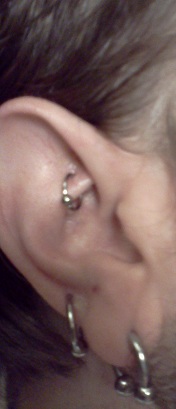
A rook piercing is a perforation of the antihelix of the ear for the purpose of wearing jewelry. It is located just above the tragus on the ridge between the inner and outer conch with the piercing passing from the underside to the top of this ridge, differing from many ear piercings that essentially span between a "front" and "back" surface. Erik Dakota, a well known professional piercer and the individual responsible for originating and popularizing the rook piercing, is said to have named this modification after a shortened version of his first name. The piercing was first named in issue #4 of the magazine Body Play and Modern Primitives Quarterly around 1992 alongside the first printed reference to the industrial piercing, then termed "industrial ear project".

Piercing migration is the process that occurs when a body piercing moves from its initial location. This process can be painful or go unnoticed, until it has progressed. Given enough time, a ring may migrate entirely outside of the skin, although it may only migrate a small amount and come to rest.

The antitragus is a feature of mammalian ear anatomy.
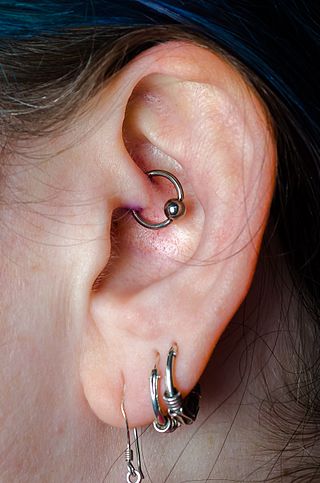
A daith piercing is an ear piercing that passes through the ear's innermost cartilage fold, the crus of the helix.

An orbital piercing is a combination of two ear piercings connected by one piece of jewelry. Usually located in the helix region of the ear, an Orbital Piercing can be done anywhere on the body including your earlobes. The piercing uses a hoop, and is not to be confused with an industrial piercing, a conch piercing or double cartilage piercing.
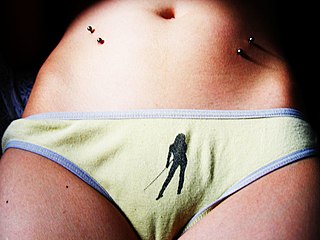
A hip piercing is a piercing in the pelvic area through the skin near the hip bone. Hip piercings are often done in couplets with one on each hip, but it is not unusual to see only one. Hips piercing are a type of surface piercing. Microdermals or skin divers can be implanted in the hip area to give a similar appearance.
A cartilage piercing can refer to any area of cartilage on the body with a perforation created for the purpose of wearing jewelry. The two most common areas with cartilage piercings are the ear and the nose. Many people outside of the body modification community often informally use the term "cartilage piercing" to refer a helix piercing. The cartilage ear piercing is known to be more sore than the lobe as in the cartilage there is less blood so it takes longer to heal.

Body piercing, which is a form of body modification, is the practice of puncturing or cutting a part of the human body, creating an opening in which jewelry may be worn, or where an implant could be inserted. The word piercing can refer to the act or practice of body piercing, or to an opening in the body created by this act or practice. It can also, by metonymy, refer to the resulting decoration, or to the decorative jewelry used. Piercing implants alter body and/or skin profile and appearance. Although the history of body piercing is obscured by popular misinformation and by a lack of scholarly reference, ample evidence exists to document that it has been practiced in various forms by multiple sexes since ancient times throughout the world. Body piercing can be performed on people of all ages, although most minors are only permitted to have earlobe piercings.
Ear piercing is one of the oldest forms of body modification. It occurs when holes are created on the ear lobes or cartilage to allow the insertion of decorative ornaments, such as earrings. Ear piercing in children has been around for centuries as part of ritualistic and cultural traditions but has continued to become a worldwide mainstream fashion statement. It is extremely common in Nigeria, India, Brazil and Hispanic countries.















